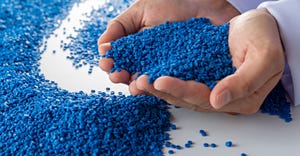Plastic Pail Earns Sustainable Stripes
Milacron and partners perfect the injection molding of a precise layer of recycled content — mechanical or advanced processes — to sustainably boost the eco-footprint of 5-gal plastic pails.

The plastic industry seeks sustainability opportunities throughout the breadth of the market from automotive to medical to packaging. It’s in the latter market where the depth of that commitment was exemplified in the plastic pail category at NPE2024 where Milacron exhibited an M-Series Model 1070 injection molding system capable of adding a core layer of recycled content.
The show marks the debut of the M-Series.
The encapsulating concept was introduced at NPE2015 for a single-cavity model, but the 2024 difference is that there is a higher output “double-cavity processing with precise control of the layer,” explains Andy Stirn, general manager advanced systems. “And that is now applicable for chemically recycled content along with mechanically recycled content.”

Milacron's M-Series injection molder. MILACRON
Participating in the demonstration this year were a collaboration of NPE partner companies Beck Automation, KW Plastics, LyondellBasell, MCC Verstraete, Mold Masters, Shell Polymers, and SyBridge Technologies.
The inner and outer layers are made of high-density polyethylene. The advanced recycling material demonstrated on May 6 was provided by LyondellBasell. Shell Polymers provides the virgin HDPE.
The at-show encapsulated post-consumer recycle (PCR) layer was 46%, according to Stirn, “but we go up to 50% with complete control of where the recycle layer is located, whether inner, middle, or outer layer.”
Food-quality pails are an option when using an inner layer of virgin plastic.
Later in the week a core layer of mechanically recycled content would be used.

Sybridge’s Matt Little and Milacron’s Andy Stirn pause at NPE2024 with the innovative pail and the injection molding system in the background. RICK LINGLE
The breakthrough is gaining traction. Stirn informs us that tests and trials are already lined up in North and South America with more to follow.
The development supports legislation that sets single-use plastic targets and recycled content goals for brand owners, which stateside is most notably forthcoming CA SB 54.
Sustainably speaking, other pails pale in comparison. But that’s not the ultimate solution because there’s more pail sustainability ahead.
SyBridge’s Matt Little, business development manager, life sciences and consumer, sees plastic handles replacing metal to simplify and maximize plastic pail recyclability.
Specializing in developing high-precision production parts, SyBridge designed the mold.
About the Author(s)
You May Also Like




